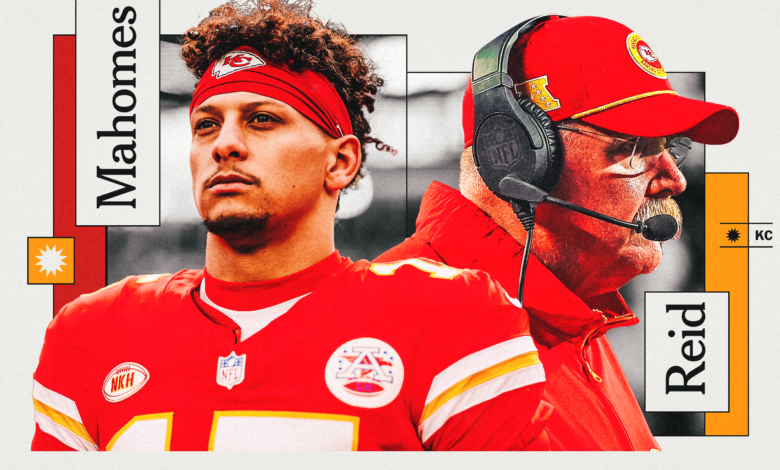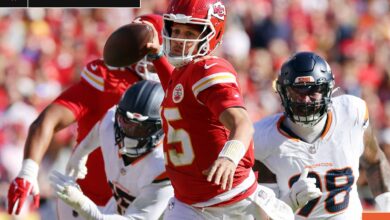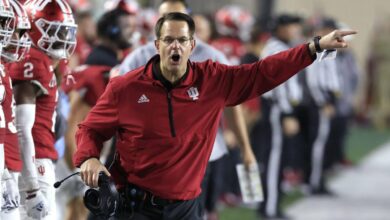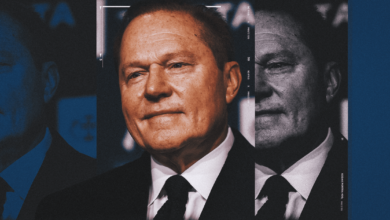The Secret to Patrick Mahomes and Andy Reid’s Creative Collaboration: ‘Let’s See How Far We Can Go’

In the days leading up to his first Super Bowl, Patrick Mahomes sat on a practice field with a small group of offensive players and coaches while the rest of the team worked on special teams.
In Mahomes’ early years as an NFL quarterback, the special teams era with the Kansas City Chiefs had become his personal laboratory — a time when he could push the boundaries of what was possible, break rules, make plays and experiment with new mechanics. Chiefs coach Andy Reid had a phrase for that mindset: “I’m going to give you the keys,” he said.
In practice for the biggest game of his young career, Mahomes turned the keys and hit the gas pedal. Sprinting to his right, he pulled the ball downfield and went all Magic Johnson, throwing a behind-the-back pass to tight end Travis Kelce. Deland McCullough, then the Chiefs’ running backs coach, watched in stunned silence.
“I’m not talking about Travis being 10 yards away,” McCullough said. “Travis was maybe 25, 30 yards away.”
It wasn’t the last time Mahomes flirted with a behind-the-back pass. He floated the possibility in interviews and lobbied Reid to let him try it in a game, convinced he could pull it off. Last season, former Chiefs receiver Marcus Kemp was so sure Mahomes still wanted to attempt a behind-the-back pass that he was reluctant to talk about it.
“I think Pat’s still trying to get it in,” Kemp said. “He’s been at it for about three years now.”
When Mahomes finally got it done in the preseason, finding Kelce against the Lions on August 17, the internet did what it always does. But the most revealing reaction came from Reid, the man who loaned Mahomes the keys all those years ago.
“I’ve been telling you to do that for a while now,” Reid told his quarterback.
The Reid-Mahomes partnership is already one of the most successful in NFL history.
In the six seasons since Mahomes became the regular starter, no team in the league has won more games or scored more points. There are also three Super Bowl trophies, six consecutive appearances in the AFC Championship game and the prospect of the first Super Bowl three-peat this season, but the relationship is about more than just results. It’s an innovative force more in line with Lennon-McCartney or Wozniak-Jobs, a prolific duo that thrives on creative collaboration.

GALLING DEEPER
Mahomes says he improvised a behind-the-back pass
Reid, the 66-year-old son of a Hollywood set designer, doesn’t want his players to color outside the lines; he wants them to push the boundaries beyond the page. Mahomes, the 28-year-old son of a major league pitcher, doesn’t just want to excel at quarterback; he wants to reimagine what the position looks like.
“(Reid) has created an environment around him where he has people around him that he feels have the same core values,” Kemp said. “I believe that’s why he brought Pat in.”
“That environment was like, ‘Wow,’” McCullough said. “The juices were always flowing.”
Reid pushed Mahomes to think bigger from their first practices together in 2017. “I want you to expand the offense,” the coach told his quarterback over and over.
That meant taking deep shots. Forcing tight throws. Exploring what was possible, even if it meant Mahomes might occasionally fail.
“Let’s see how far we can go,” Reid said.
As the two grew more comfortable with each other — and Mahomes flashed a rare talent — they developed a creative energy that allowed them to push their individual skills to the max. Reid was the offensive guru who would try anything, the kind of tinkerer who once put a 350-pound nose tackle on a running back and begged his assistants to follow a simple rule: “Don’t judge.” Mahomes was the quarterback who believed he could do it all, a risk-taker who unleashed his first no-look pass during the fourth quarter of a close college game.
Experienced players in Kansas City noticed something in the early years.
“That youthful exuberance that Pat had rubbed off on Coach and gave him a little bit of life,” said Mitchell Schwartz, a former Chiefs offensive lineman. “Because he didn’t have to be so regimented. He had this guy who could do what he wanted to do.”
Reid’s willingness to scout allowed Mahomes to tap into the full depth of his unique and often unconventional skill set. When Mahomes replaced Alex Smith in 2017, he led the scout team. One day, Reid whistled and called out Brad Childress, then the team’s assistant head coach. Reid told Childress to grab his play sheet and start marking the plays: “Play 3, Play 5, Play 6, Play 8…”
Reid had just watched Mahomes throw at least four no-look passes, much to the surprise of veteran linebacker Justin Houston and the rest of the first-team defense.
“Justin Houston’s reaction — it was unbelievable,” Childress said. “He looked in the flat. He looked at the quarterback. He looked where the ball was completed. He looked at Coach Reid. He looked back at the quarterback. He looked back at the flat. He said, ‘What just happened?'”
Reid kept his poker face. Just watch the film of those plays, he told Childress. But Childress had been around long enough to know: Reid was hiding a smile.

Patrick Mahomes confers with Andy Reid before Super Bowl LVIII in February. (Harry How/Getty Images)
When Schwartz played for the Chiefs from 2016 to 2020, the team held a walkthrough practice on Tuesdays after watching film. Players wore street clothes. No cleats. Pretty casual.
There was one unique trait: Every week, Reid would walk around with a small piece of paper filled with new plays that even his assistant coaches had never seen before. To players and coaches, Reid looked like a man weaving through a full-size chessboard, pulling receivers into new spots, moving a tight end a few yards in this fashion, trying to visualize the geometry.
It wasn’t a solo process. Reid would hold up a notecard in the huddle so players could, as Kemp said, “figure it out in their head.” Then they would line up. Most of the time, the play didn’t even have a name.
“He can go through seven or eight things and maybe four of them will make it to the finish line,” McCullough said.
The process felt so elemental — like a play was being conceived in real time — that it demystified the process. Players were given the opportunity to make their own suggestions and adjustments. It was exactly what Reid wanted.
“That’s where Patrick started to get comfortable enough to create those plays himself,” Kemp said. “It was seeing the head guy do it and working it out on the field. You didn’t have to have a perfect play that you had to take to him.”
Under Reid, the Chiefs have become famous for mining plays from everywhere: friends, rivals, college games, the 1948 Rose Bowl. Even from seemingly insane ideas during walkthroughs.
“I feel like the coach just observes what Pat does in practice and likes it and thinks, ‘Hmm, that could be pretty cool,’” Schwartz said.
The most out-of-the-box team-up of the Reid-Mahomes era came on Jan. 7, 2023. That was the day the Chiefs staged “Arctic Circle” — also known as the “Circle of Death” — a play that began with a spinning huddle and descended into pure anarchy.
Running back Jerick McKinnon lined up as a shotgun, ran a run-pass option and threw the ball to Mahomes, who stopped and tossed the ball back to receiver Kadarius Toney, who ran to the end zone, but the touchdown was negated by a holding penalty.
The plan was pure razzle-dazzle, but the spinning huddle was even weirder. The only people unimpressed were the players on the field.
“We’ve been seeing it in various capacities for almost a year now,” Kemp said.
The play was born during a series of Saturday walkthroughs, where the Chiefs ran through a list of Hail Marys and end-of-game trick plays. After four or five years of running many of the same looks, the staff began looking for ways to spice things up.
“That’s a time for Pat and the whole offense to get creative,” Kemp said. “It doesn’t really matter if it’s legal or not.”
At one point someone asked: what if we all turned around in a circle before we left the group?
What looked like chaos was actually a carefully crafted script: Reid took an odd idea and laid it out step by step, a hallmark of his success. “He’ll cherry-pick the details so he can explain it over and over again,” Kemp said. “He told everybody specifically which way to go and when to stop and who would call it and where to end the receivers and how to do specific things. I think that’s why it worked: details.”
After several Saturdays of tinkering with and perfecting the circle of death concept, Reid concluded: Let’s put it in.
Of course, Mahomes has the kind of talent that makes any idea seem like a good idea. “Pat’s one of those guys that’s really good at a lot of the things he does,” Kemp said, “so he’ll do something randomly and it just clicks for him or a coach and they find a way to incorporate it.”
When Mahomes became the starter in 2018, he began lobbying for an underhand shovel pass because he felt it would disguise the play better than a traditional shovel pass. When the timing didn’t work, Reid built a new formation over the course of two or three weeks to make it work.
The play became a permanent part of the program.
Around the same time, Mahomes center Austin Reiter began taking practice snaps while running. It started as a fun practice experiment, but soon quarterback assistant coach Tom Melvin asked if it was legal, and then he took it to the finishing lab — the special teams period — where he worked on plays with Kelce. All that was left was Reid, who installed a play called “Ferrari Right.”
“Coach Reid knows that fine line where he’s just crazy enough but also just safe enough,” said Anthony Gordon, a former Chiefs quarterback.
“It was never a tense environment,” added Matt McGloin, another former quarterback. “It was always fun. It was always exciting. You were always learning, which was incredible. It was always a big team effort.”
The day before the 2018 season, Mahomes and Reid ran through a game plan for an upcoming preseason game. Mahomes had made one career start, against Denver the year before, and Reid was in his 20th season as an NFL head coach. But when Mahomes said he didn’t like a play in the plan, Reid cut it.
“That’s the confidence Andy had in his players,” McGloin said.
Six years later, the collaboration is flourishing.
On the eve of last season’s AFC Championship Game in Baltimore, Mahomes sat in another meeting with Reid as the team’s offensive staff discussed end-of-game plays. If they needed to convert a third-and-long to win the game, Mahomes said he wanted a play that could beat man-to-man coverage and counter the Ravens’ pressure.
The next night, the Chiefs led the Ravens 17-10 with 2:19 left. It was third and 9. Mahomes walked to the sideline.
“Give me the ball“, he said.
Reid knew the play Mahomes wanted. He gave Mahomes the keys again.
The Chiefs lined up three receivers on the left side, the Ravens showed Cover Zero and Mahomes found receiver Marques Valdes-Scantling with a deep drive over the middle, sending Kansas City back to the Super Bowl.
(Illustration: Meech Robinson / The Athletics; photos: Ryan Kang/Getty Images; David Eulitt/Getty Images)




